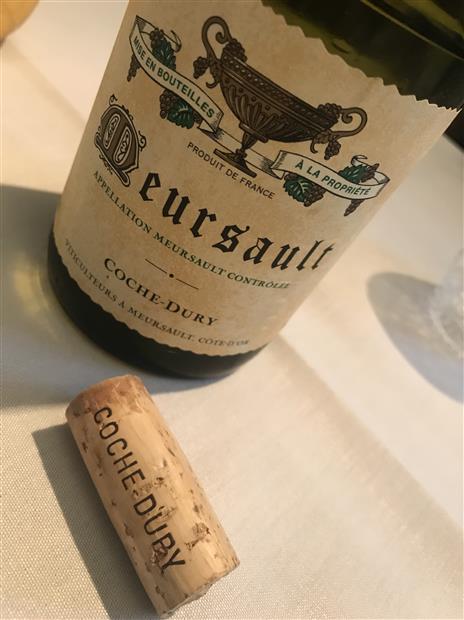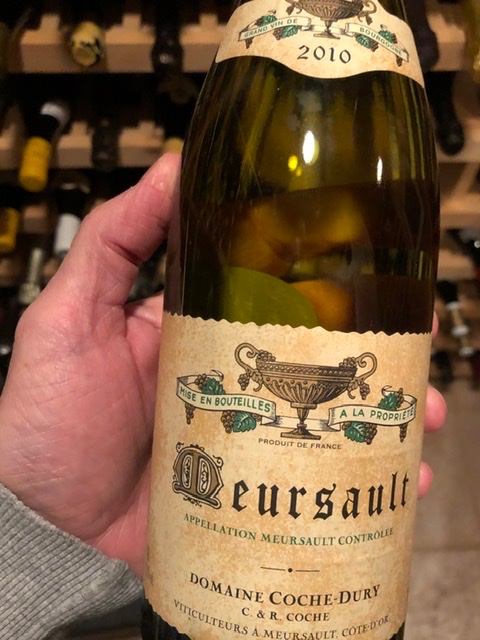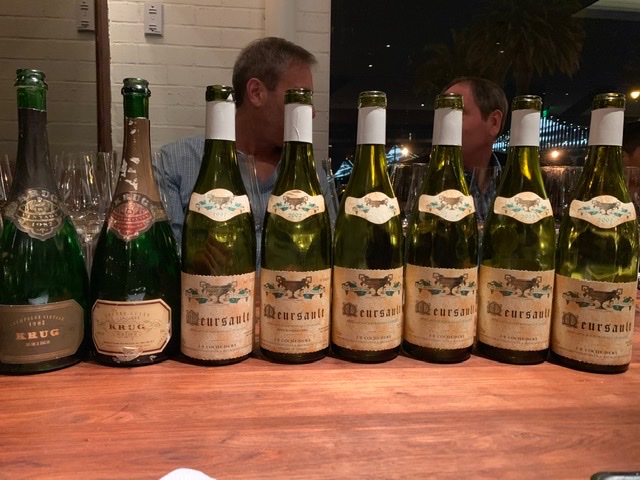
2016 Coche-Dury Meursault - France, Burgundy, Côte de Beaune, Meursault (12/20/2019)
Lunchwine in Belgium | From the Les Vireuils vineyard this was tight, young, focused, with fine clarity of delicious citrus fruit. Powerful and long with a mineral, stony finish. (93 pts.)
Posted from CellarTracker
That was better than my lunch.
Domaine and Selection or Coche Dury?
I was under the impression they blended the vireuils from Domaine and Selection.
We had the 2016 at one of our local holiday lunches last Friday. Great bottle.
-
2016 Coche-Dury Meursault - France, Burgundy, Côte de Beaune, Meursault (12/14/2019)
Drunk at the same lunch as the 2012, and the 2016 was a step function above the 2012. Like many of the 2016 whites, I found this expressive, lovely, and overall a great drink.
Posted from CellarTracker
Fred, here’s from William Kelley’s note on WA. “This note applies to a bottle from a cuvée produced from the lieu-dit Les Chaumes that also contains some juice from La Barre. Raphaël Coche told me that he produced three other cuvées, one from Vireuils, another from Narvaux and a third assembling multiple parcels that together filled a press. As usual, the only way to know which bottling you possess is to ask the importer.”
Thanks Brad! That William Kelley is a great resource.
There are two bottlings of Vireuils made at Domaine Coche-Dury. The one that was tasted above by Barry is made from a parcel owned by the Coche family in the upper section of Vireuils, “Dessus”, and is bottled on its own and simply labeled as Meursault AC under the domaine’s own label. As William noted, the same label is used for their bottling of Narvaux and the blended AC cuvee (which includes a good bit of Luchets). I believe that Kermit Lynch usually gets the Narvaux bottling as their version of Meursault AC for the US market. The second is the Domaines et Selections bottling made from a parcel of vines in the lower half of the vineyard, “Dessous”, with this parcel of vines owned by Johann Bjorkland (who also owns the l’Hotel de Beaune) and Johann contracts with the Coche family to farm the parcel and make a separate bottling. I do not know the terms of the agreement between Monsieur Bjorkland and the Coche family regarding this parcel of vines, but it is my understanding that the domaine’s version of Vireuils has always been made exclusively from their family-owned parcel in Dessus and never blended with production from Johann’s vines in the lower section of the vineyard.
A little confused here. Did a small vertical a couple of months ago with Fred pictured here and I just took a pic of a bottle of 2010 in my cellar. Labels all look slightly different. How can you tell which vineyards are used by looking at the label?


It is my understanding that there is no way to tell the difference which lieu a dit of Meursault AC you have by the label. Maybe there is some discreet code somewhere that I am unaware of, but I have never been able to find anything.
![]()
No, there is no way; and they don’t even like talking about it too much at the domaine, as people start asking for one rather than another and it gets complicated.
I think that in fact there might be more bottlings than those these days, John; but one or the other of us will have to remember to ask next time we make it to the domaine. As for the Domaine & Selection bottling by Coche, I have not seen a new vintage for several years so I figured that had wrapped up—but this is just speculation on my part, so I would welcome correction if I am mistaken.
Any thoughts on how this vintage compares to the wines of Raphaël’s father at a similar age?
Here’s what I wrote in my last report in TWA:
The last few vintages have witnessed a stylistic evolution at Domaine Coche-Dury that I took the opportunity to discuss with Raphaël. In Raphaël’s words, the domaine now works with “less new oak, less bâtonnage and less lees.” The distinctively toasty, reductive signature that marked out the Coche-Dury wines of yesteryear is no more. But, as Raphaël emphasizes, that has been the case for some time. “The last vintages marked by pronounced reduction were 1999 and 2007,” he observes. “And I didn’t initiate the move toward a purer, less stylized approach alone: Jean-François and I agreed on the change of direction together.” Some clients, Raphaël says, have complained, but his response is uncompromising. “They may want the vinification [techniques] in the glass, but I want to taste the terroir.”
The fundamentals of Domaine Coche-Dury’s greatness, it’s important to emphasize, remain the same: high-quality viticulture, a rare aptitude—which seems to have been passed down from father to son—for knowing how hard to press and for how long, careful choice of barrels and long, meticulously supervised élevage. The wines continue to be distinguished by their incisive acids, striking intensity and frequently appreciable presence of dry extract—the latter is something Raphaël argues can bring structure and freshness to wines from the warm vintages that Burgundy is witnessing more and more frequently. There isn’t a Coche formula, rather there is a Coche palate, for decisions are made by tasting. “When my grandfather used to say winemaking was an art, sometimes I wondered what he had been smoking, but more and more I agree—it’s all a question of feeling,” says Raphaël. Jean-François, I should add, is also very much a continuing presence at the domaine. “My father comes by every day and gives his opinion,” Raphaël confirms.
Tasting Coche-Dury’s 2015 Meursault Perrières—pure, searingly intense and structured like a red wine—it was impossible to argue with the domaine’s evolution. It’s a magical wine that represents the essence of this great vineyard. The 2016 portfolio is also very compelling. After the year’s frosts, Jean-François advised his son to “sell everything in bulk and buy nothing—the wines will never be good.” Raphaël, however, opted to persevere, harvesting only first-generation grapes (and not the second- and third-generation fruit included in many of the year’s less successful white Burgundies) and purchasing some fruit to supplement some of the domaine’s more depleted cuvées, notably the Bourgogne Blanc and Meursault Rouge. The result is a set of wines that rank among the vintage’s best and that I suspect may give the Domaine’s 2014s stiff competition. Our tasting concluded with the 2013 Corton-Charlemagne, a wine that hails from what Raphaël calls the most challenging vintage of his career.
Since then, I have gone into the subject even deeper, some of which will come out in my next vintage report in early January. The rest I’m saving for a super in-depth piece on the domaine, including notes back to 1947 (when it was Domaine Coche-Vincent). But happy to try to answer any more specific questions you might have to the best of my ability.
Thank you William - awesome info and background!
Agree, William is fantastic and an extremely valuable contributor to this forum. Thank you William.
+1
+1
Thanks William, wonderful details. I have a question: What do you mean when you write of the 2015 Meursault Perrières, “structured like a red wine?” I think of tannins as the most notable difference in structure between reds and whites. Are you referring to a different aspect of structure?